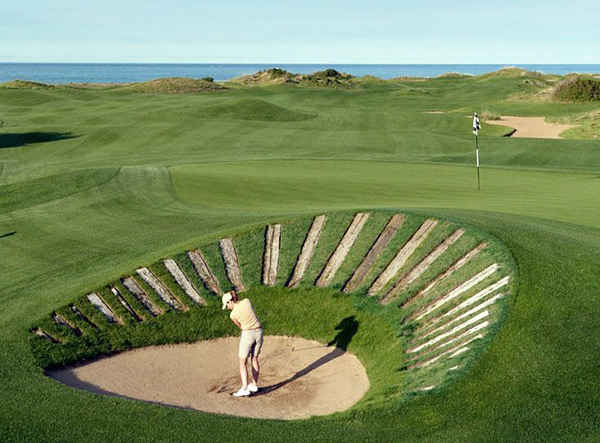Why is links golf hard?

Why Links Golf is Challenging?
Natural Terrain
Links courses are typically built on coastal areas with sandy soil, dunes, and tall grasses. The undulating terrain presents irregular lies, unpredictable bounces, and challenging stances for golfers.
Bunkers and Rough
Links courses feature numerous bunkers strategically placed to catch errant shots. The deep, revetted faces of these bunkers make it difficult to escape, penalizing wayward shots. Additionally, thick roughs lining the fairways demand accuracy off the tee.
Weather Conditions
The exposed nature of links courses subjects golfers to the whims of Mother Nature. Strong winds are a constant factor, altering ball flight and making club selection tricky. Rain, fog, and even sun glare can further complicate matters, testing players’ adaptability and resilience.
Firm and Fast Greens
Links greens are renowned for their firmness and speed, resembling tabletops. The hard turf and minimal irrigation result in fast, true rolls, but they also amplify the challenge of holding approach shots and controlling putting speed.
Strategic Design
Links courses often feature blind shots, hidden hazards, and subtle contours that require careful navigation and strategic thinking. Golfers must rely on course knowledge, precise yardage calculations, and creative shotmaking to score well.
Interesting Facts and Historical Significance

- Origins
Links golf finds its roots in Scotland, where the game was initially played during the 15th century. The Old Course at St. Andrews, dating back to the 16th century, is considered the oldest golf course in the world and remains a mecca for golf enthusiasts.
- The Open Championship
The Open Championship, the oldest of golf’s major championships, is synonymous with links golf. Dating back to 1860, it is traditionally held on prestigious links courses across the UK, including St. Andrews, Royal Birkdale, and Royal St. George’s.
- Links Architecture
Links courses are characterized by minimalistic design principles that prioritize natural features over artificial embellishments. Architects like Old Tom Morris, Alister MacKenzie, and Donald Ross have left indelible marks on the landscape of links golf with their innovative designs.
- The Claret Jug
The winner of The Open Championship is awarded the iconic Claret Jug, a trophy steeped in tradition and prestige. The jug’s design, featuring intricate engravings and a sleek silver finish, symbolizes the rich heritage of links golf and its enduring appeal.
- Challenges and Triumphs
Links golf has witnessed countless memorable moments and heroic performances throughout its storied history. From Tom Watson’s “Duel in the Sun” with Jack Nicklaus at Turnberry to Tiger Woods’ dominant victory at St. Andrews in 2000, the drama and excitement of links golf continue to captivate audiences worldwide.












